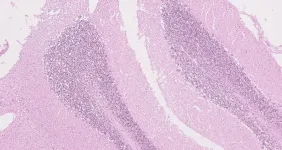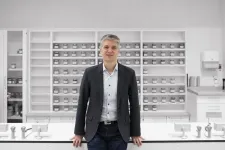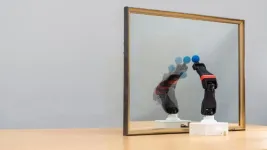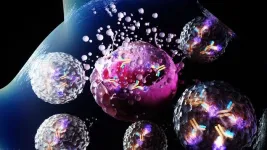Rebels of health care use technology to connect with clinicians, information, and each other
A new survey led by Susannah Fox, author of" Rebel Health: A Field Guide to the Patient-Led Revolution in Medical Care"
2025-02-25
(Press-News.org)
Rebels of health care use technology to connect with clinicians, information, and each other
Cambridge, MA – February 25, 2025 – The future of health care is being forged in the crucible of rare disease. A new survey led by Susannah Fox, author of Rebel Health: A Field Guide to the Patient-Led Revolution in Medical Care (The MIT Press), finds that 15% of U.S. households are affected by rare disease or an undiagnosed illness. Their lives are characterized by extreme stress, often matched by their resourcefulness.
“People living with rare diseases push the edges of what is possible by using technology to connect with clinicians, with new information sources, and with each other,” says Susannah Fox, author of the report, Rare Disease in the U.S. 2025. “They demonstrate that ingenuity and being open to learning from peers can overcome the confusion and loneliness of an unusual diagnosis. Truly, there are people who would love to help you, if only they knew how to find you.”
The first probability-based national survey to measure the rare disease population has found that 8% of U.S. adults say they or someone they live with has ever been told by a doctor or other health professional that they have a rare disease (defined as affecting fewer than 200,000 people in the U.S.). Moreover, an additional 7% of U.S. adults living in non-rare-disease households say they or someone they live with is currently experiencing an illness that doctors or other health care professionals have not been able to diagnose. Together, they represent 15% of U.S. households, nearly 20 million, affected by rare disease or an undiagnosed illness.
Telehealth options are important to rare disease households: 63% of adults living in rare disease households have, in the past year, seen a doctor or other health care provider, such as a specialist, online or via a telehealth appointment, compared with 45% of those not living in a rare disease household. Twenty-nine percent have, in the past year, seen a mental health professional or therapist online or via a telehealth appointment, compared with 18% of survey respondents who do not live in a rare disease household.
Connections with health peers are a key resource: Half of survey respondents who reported living in a rare disease household say they have, in the past year, gone online to find other people who might have health concerns similar to their own, compared with 37% of those not living in a rare disease household.
AI as a research assistant: In addition, 38% of respondents living in a rare disease household have, in the past year, used an AI tool such as ChatGPT or Gemini to learn about a health condition or treatment options, compared with 21% of those not living in a rare disease household.
This study was conducted by SSRS, a Pennsylvania-based research firm, on its Opinion Panel Omnibus platform for Susannah Fox and ARCHANGELS, with support from the Association on Aging in New York. Respondents living in rare disease households are from every region of the U.S., with no significant differences among age groups, people with various levels of education or income, or political party identification.
###
The SSRS Opinion Panel Omnibus is a national, twice-per-month, probability-based survey. Data collection was conducted on two waves of the omnibus, from January 17 to January 21, 2025, and from February 7 to February 10, 2025, among a total sample of N = 2,012 respondents. The survey was conducted via web (n = 1,952) and telephone (n = 60) and administered in English (n = 2,012). More information about the SSRS Opinion Panel can be found at www.ssrs.com.
All SSRS Opinion Panel Omnibus data are weighted to represent the target population of U.S. adults ages 18 or older. The margin of error for total respondents is +/- 2.6 percentage points at the 95% confidence level.
Susannah Fox helps people navigate health and technology. She served as Chief Technology Officer for the US Department of Health and Human Services, where she led an open data and innovation lab. Prior to that, she was the entrepreneur-in-residence at the Robert Wood Johnson Foundation and directed the health portfolio at the Pew Research Center's Internet Project. The paperback edition of Rebel Health goes on sale from The MIT Press March 4th, 2025. For more information, visit her website at https://susannahfox.com/.
END
[Attachments] See images for this press release:
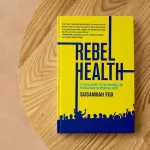
ELSE PRESS RELEASES FROM THIS DATE:
2025-02-25
The Beatles said it best: Love is all you need. And according to new research from The Australian National University (ANU), the same is true in the animal kingdom. Well, at least for mosquitofish – a matchstick-sized fish endemic to Central America and now found globally.
According to the ANU scientists, male mosquitofish possess impressive problem-solving skills and can successfully navigate mazes and other tests. Males that perform better have a higher chance of mating.
Lead author Dr Ivan Vinogradov said male mosquitofish ...
2025-02-25
Mars is easily identifiable in the night sky by its prominent red hue. Thanks to the fleet of spacecraft that have studied the planet over the last decades, we know that this red colour is due to rusted iron minerals in the dust. That is, iron bound up in Mars’s rocks has at some point reacted with liquid water, or water and oxygen in the air, similar to how rust forms on Earth.
Over billions of years this rusty material – iron oxide – has been broken down into dust and spread all around the planet by winds, a process that continues today.
But iron ...
2025-02-25
Statement Highlights:
It is essential for health care professionals to routinely screen pregnant and postpartum women for depression and anxiety, address modifiable risk factors and consider behavioral and pharmacological interventions to improve long-term maternal health outcomes.
Multidisciplinary care teams, including psychologists and other behavioral health professionals, are important to monitor and provide appropriate mental health support during pregnancy and after birth.
The new ...
2025-02-25
New research from Emory University indicates that childhood trauma physically alters the hearts of Black women.
The study, which examined the relationship between childhood exposure to trauma and vascular dysfunction among more than 400 Black adults in Atlanta ages 30 to 70, found that women who experienced childhood trauma had a worse vascular function, a preclinical marker of heart disease, while men had none. In addition, the findings show women may be more vulnerable to a larger cumulative stress burden, eliciting varying physiological ...
2025-02-25
PROVIDENCE, R.I. [Brown University] — Mars has captivated scientists and the public alike for centuries. One of the biggest reasons is the planet’s reddish hue, earning the third rock from the sun one its most popular nicknames — the “Red Planet.” But what exactly gives the planet its iconic color? Scientists have wondered this for as long as they’ve studied the planet. Today, they may finally have a concrete answer, one that ties into Mar’s watery past.
Results from a new study published in the journal Nature Communications and led by researchers from Brown University and the University of Bern suggest that the water-rich iron mineral ...
2025-02-25
Despite what was previously thought, new research has shown that genetic changes alone cannot explain why and where tumours grow in those with genetic condition neurofibromatosis type 1 (NF-1). Understanding more about the factors involved could, in the future, facilitate early cancer detection in NF-1 patients and even point towards new treatments.
Researchers from the Wellcome Sanger Institute, UCL Great Ormond Street Institute of Child Health, Great Ormond Street Hospital, Cambridge University Hospitals NHS Foundation Trust, and their collaborators, focused on NF-1, a genetic condition that causes ...
2025-02-25
One particular challenge in the treatment of cancer is therapy resistance. An international research team has now discovered a mechanism that opens up new treatment strategies for tumours in which conventional chemotherapeutic agents have reached their limits. "Cytotoxic agents from nature lead to an increased incorporation of polyunsaturated fatty acids into the membrane of cancer cells. This makes them more susceptible to ferroptosis, a type of cell death, at a very early stage," reports Andreas Koeberle, a pharmacist at the University of Graz and lead author of the study, which has just been published in the scientific journal Nature ...
2025-02-25
New York, NY—Feb. 25, 2025— By watching their own motions with a camera, robots can teach themselves about the structure of their own bodies and how they move, a new study from researchers at Columbia Engineering now reveals. Equipped with this knowledge, the robots could not only plan their own actions, but also overcome damage to their bodies.
"Like humans learning to dance by watching their mirror reflection, robots now use raw video to build kinematic self-awareness," says study lead author Yuhang Hu, a doctoral student at the Creative Machines Lab at Columbia University, directed by Hod Lipson, James and Sally Scapa Professor of Innovation and chair of the Department ...
2025-02-25
HOUSTON ― Researchers at The University of Texas MD Anderson Cancer Center have developed a novel antibody-toxin conjugate (ATC) designed to stimulate immune-mediated eradication of tumors. According to preclinical results published today in Nature Cancer, the new approach combined the benefits of more well-known antibody-drug conjugates (ADCs) with those of immunotherapies.
ADCs have emerged as a breakthrough in recent years due to their modular design, which enables precise delivery of therapies to tumors by targeting specific proteins expressed on cancer cells. These conjugates ...
2025-02-25
Toronto, ON – A new study published this week in Archives of Gerontology and Geriatrics Plus found that 10% of South Asian immigrants aged 45 and older in Canada had hypothyroidism. After adjustment for a wide range of sociodemographic characteristics and health behaviors, those who had immigrated from South Asia had 77% higher odds of hypothyroidism than those born in Canada.
“To the best of our knowledge, this is the first study to identify a significantly higher odds of hypothyroidism among immigrants of South Asian descent,” says senior author Esme Fuller-Thomson, a Professor at Factor-Inwentash Faculty of Social Work (FIFSW) and Director ...
LAST 30 PRESS RELEASES:
[Press-News.org] Rebels of health care use technology to connect with clinicians, information, and each other
A new survey led by Susannah Fox, author of" Rebel Health: A Field Guide to the Patient-Led Revolution in Medical Care"




